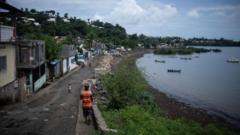Mayotte, a French territory in the Indian Ocean, has been ravaged by Cyclone Chido, which made landfall with devastating winds and destruction.
Cyclone Chido Devastates Mayotte, Leaving Behind Destruction and Casualties

Cyclone Chido Devastates Mayotte, Leaving Behind Destruction and Casualties
Mayotte's inhabitants face a humanitarian crisis after the cyclone's destruction, with officials fearing a significant loss of life.
In the wake of Cyclone Chido hitting France's Indian Ocean territory of Mayotte, local officials report significant devastation and potential casualties. The cyclone, described as the worst to strike the island in nearly a hundred years, made landfall on Saturday with wind gusts exceeding 225km/h (140mph). Initial reports have confirmed at least two fatalities, but fears abound regarding a possible higher death toll amidst the wreckage.
Authorities on the island indicated that the local shanty town suffered catastrophic damage, prompting French Interior Minister Bruno Retailleau to declare his concerns for a "heavy" loss of life. In response to the disaster, French President Emmanuel Macron assured citizens that France would provide necessary support, while 250 firefighters and personnel were dispatched to aid recovery efforts.
The cyclone, which hit north-west of Madagascar, severely impacted infrastructure even before it made landfall. With fallen trees, roofs torn off buildings, and downed power lines, emergency services were rendered nearly powerless as they struggled to communicate amidst the chaos. Abdoul Karim Ahmed Allaoui, head of the firefighters' union, described the challenges faced by emergency responders, who were stuck without mobile service and unable to reach anyone in need.
Reports indicate that buildings designed to withstand earthquakes performed poorly against the cyclone's strength, necessitating the evacuation of the emergency services command centre. Pamandzi airport sustained substantial damage, particularly to the control tower, complicating air traffic as military aid planes were prepared for deployment to assist.
Retailleau emphasized the state's commitment to aiding the residents of Mayotte. Following a "purple alert" — the highest warning level — a lockdown initially confined both residents and emergency responders. This was later downgraded to a red alert to allow emergency services to operate.
French Prime Minister François Bayrou, fresh in his role, acknowledged the "exceptional severity" of the cyclone and committed to receiving real-time updates on the situation. Concurrently, forecasts indicate that the cyclone may now be on a path toward Mozambique, raising concerns for further impact on the mainland African region.
This catastrophe underscores the ongoing struggles of island communities in the face of severe weather conditions, enhancing the urgency for timely responses and support from both local and international entities.
Authorities on the island indicated that the local shanty town suffered catastrophic damage, prompting French Interior Minister Bruno Retailleau to declare his concerns for a "heavy" loss of life. In response to the disaster, French President Emmanuel Macron assured citizens that France would provide necessary support, while 250 firefighters and personnel were dispatched to aid recovery efforts.
The cyclone, which hit north-west of Madagascar, severely impacted infrastructure even before it made landfall. With fallen trees, roofs torn off buildings, and downed power lines, emergency services were rendered nearly powerless as they struggled to communicate amidst the chaos. Abdoul Karim Ahmed Allaoui, head of the firefighters' union, described the challenges faced by emergency responders, who were stuck without mobile service and unable to reach anyone in need.
Reports indicate that buildings designed to withstand earthquakes performed poorly against the cyclone's strength, necessitating the evacuation of the emergency services command centre. Pamandzi airport sustained substantial damage, particularly to the control tower, complicating air traffic as military aid planes were prepared for deployment to assist.
Retailleau emphasized the state's commitment to aiding the residents of Mayotte. Following a "purple alert" — the highest warning level — a lockdown initially confined both residents and emergency responders. This was later downgraded to a red alert to allow emergency services to operate.
French Prime Minister François Bayrou, fresh in his role, acknowledged the "exceptional severity" of the cyclone and committed to receiving real-time updates on the situation. Concurrently, forecasts indicate that the cyclone may now be on a path toward Mozambique, raising concerns for further impact on the mainland African region.
This catastrophe underscores the ongoing struggles of island communities in the face of severe weather conditions, enhancing the urgency for timely responses and support from both local and international entities.




















